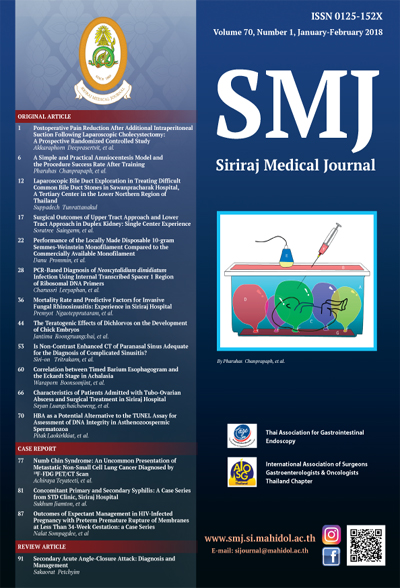Mortality Rate and Predictive Factors for Invasive Fungal Rhinosinusitis: Experience in Siriraj Hospital
Keywords:
Invasive fungal rhinosinusitis; fungal infection; mucormycosis; aspergillosis; prognosis; mortalityAbstract
Objective: To elucidate the mortality rate and prognostic factors in patients with invasive fungal rhinosinusitis in Siriraj Hospital.
Methods: Thirty-nine patients with a definitive diagnosis of invasive fungal rhinosinusitis were recruited from October 2003 to September 2014. The mortality rate was retrieved, and the impacts of underlying diseases, clinical presentation, disease extension, fungal types, antifungal drugs, and time to treatment were statistically analyzed.
Results: The overall mortality rate was 23.1%. All patients except one were immunocompromised. Cranial nerve involvement was the most common symptom. The ethmoid sinus was the most commonly affected intranasal site (46.2%), and the majority of extranasal lesions were located in the orbit (17.9%). Most patients were affected by Aspergillus spp. (64.1%). Alteration of consciousness and periorbital pain were significant negative prognostic factors [adjusted odds ratio (95% confidence interval), 10.37 (1.31–82.07) and 8.67 (1.30–57.88), respectively]. Other factors such as time to treatment, age, and central nervous system involvement had no effect on mortality.
Conclusion: The mortality rate of invasive fungal rhinosinusitis in this study was 23.1%. Negative prognostic factors were alteration of consciousness and periorbital pain. Clinicians must have a high index of suspicion for invasive fungal rhinosinusitis, and aggressive treatment should be considered.
Downloads
Published
How to Cite
Issue
Section
License
Authors who publish with this journal agree to the following conditions:
Copyright Transfer
In submitting a manuscript, the authors acknowledge that the work will become the copyrighted property of Siriraj Medical Journal upon publication.
License
Articles are licensed under a Creative Commons Attribution-NonCommercial-NoDerivatives 4.0 International License (CC BY-NC-ND 4.0). This license allows for the sharing of the work for non-commercial purposes with proper attribution to the authors and the journal. However, it does not permit modifications or the creation of derivative works.
Sharing and Access
Authors are encouraged to share their article on their personal or institutional websites and through other non-commercial platforms. Doing so can increase readership and citations.











